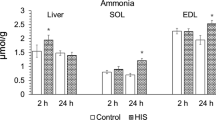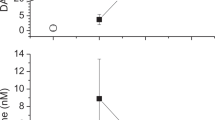Summary
Plasma norepinephrine concentrations are often elevated in patients with hepatic cirrhosis in relation to the stage of disease and possibly in response to a decrease in “effective” arterial blood volume. Since tyrosine, the precursor for catecholamines, is said to influence the rate of catecholamine biosynthesis within the central nervous system and peripheral sympathetic structures, we tested whether basal hypertyrosinemia and increased plasma tyrosine levels after oral loading with l-tyrosine are associated with elevated plasma catecholamine concentrations. Baseline norepinephrine (NE) and epinephrine (E) were significantly higher in 17 patients with decompensated cirrhosis, as compared with 11 healthy controls (NE: 809±108 pg/ml vs 295±16 pg/ml; E: 69±9 pg/ml vs 36±8 pg/ml). No significant correlation between the basal plasma tyrosine and norepinephrine level could be demonstrated in patients with cirrhosis (r=0.04). Oral tyrosine loading (100 mg/kg b.w.) administered in six equal doses did not change the level of catecholamines, whereas plasma tyrosine increased two- to three-fold. Even a large single dose (14 g l-tyrosine) failed to alter plasma catecholamines in six cirrhotic patients with marked ascites. We therefore conclude that the enhanced availability of tyrosine in cirrhotics does not influence catecholamine biosynthesis in peripheral sympathetic neurons.
Similar content being viewed by others
Abbreviations
- D:
-
dopamine
- E:
-
epinephrine
- NE:
-
norepinephrine
- Tyr:
-
tyrosine
References
Agharanya JC, Wurtman RJ (1982) Effect of acute administration of large neutral and other amino acids on urinary excretion of catecholamines. Life Sci 30:739–746
Agharanya JC, Wurtman RJ (1982) Studies on the mechanism by which tyrosine raises urinary catecholamines. Biochem Pharmacol 31:3577–3580
Agharanya JC, Alonso R, Wurtman RJ (1981) Changes in catecholamine excretion after short-term tyrosine ingestion in normally fed human subjects. Am J Clin Nutr 34:82–87
Alonso R, Agharanya JC, Wurtman RJ (1980) Tyrosine loading enhances catecholamine excretion by rats. J Neural Transm 49:31–43
Alonso R, Gibson CJ, Wurtman RJ, Agharanya JC, Prieto L (1982) Elevation of urinary catecholamines and their metabolites following tyrosine administration in humans. Biol Psychol 17:781–790
Andersson SM, Salaspuro M, Ohisalo JJ (1982) Metabolic basis of hypertyrosinemia in liver disease. Gastroenterology 82:554–557
Axelrod J, Tomchick R (1958) Enzymatic o-methylation of epinephrine and other catechols. J Biol Chem 233:702–705
Badawy AAB, Williams DL (1982) Enhancement of rat brain catecholamine synthesis by administration of small doses of tyrosine and evidence for substrate inhibition of tyrosine hydroxylase activity by large doses of the amino acid. Biochem J. 206:165–168
Benedict CR, Anderson GH, Sole MJ (1983) The influence of oral tyrosine and tryptophan feeding on plasma catecholamines in man. Am J Clin Nutr 38:429–435
Bortz J (1977) Lehrbuch der Statistik. Springer, Berlin
Burghardt W, Wernze H (1985) Plasmakatecholamine als prognostischer Indikator bei Leberzirrhose: Dissoziation zwischen Plasma-Renin-Aktivität (PRA), Aldosteron and Plasma-Noradrenalin in verschiedenen Zirrhosestadien. Klin Wochenschr [Suppl IV] 63:178
Cuche JL, Prinseau J, Selz F, Ruget G, Tual JL, Reingeissen L, Devoisin M, Boglin A, Guédon J, Fritel D (1985) Oral load of tyrosine or L-dopa and plasma levels of free and sulfoconjugated catecholamines in healthy men. Hypertension 7:81–89
Epstein M (1983) Renal sodium handling in cirrhosis. In: Epstein M (ed) The kidney in liver disease. 2nd Edn Elsevier, New York, pp 25–53
Esler M, Willet J, Leonard P, Hasking G, Johns J, Little P, Jennings G (1984) Plasma noradrenaline kinetics in humans. J Auton Nerv Syst 11:125–144
Gibson CJ, Wurtman RJ (1977) Physiological control of brain catechol synthesis by brain tyrosine concentration. Biochem Pharmacol 26:1137–1142
Growdon JH, Melamed E, Logue M, Hefti F, Wurtman RJ (1982) Effects of oral L-tyrosine administration on CSF tyrosine and homovanillic acid levels in patients with Parkinson's disease. Life Sci 30:827–832
Henriksen JH, Christensen NJ, Ring-Larsen H (1981) Noradrenaline and adrenaline concentrations in various vascular beds in patients with cirrhosis. Relation to haemodynamics. Clin Physiol 1:293–304
Hörtnagl H, Lochs H, Kleinberger G, Hackl JM, Hammerle AF, Binder H, Wewalka F (1981) Plasma catecholamines in hepatic coma and liver cirrhosis: Role of octopamine. Klin Wochenschr 59:1159–1164
Levine RJ, Conn HO (1967) Tyrosine metabolism in patients with liver disease. J Clin Invest 46:2012–2020
Morgan MY, Marshall AW, Milsom JP, Sherlock S (1982) Plasma amino-acid patterns in liver disease. Gut 23:362–370
Peuler JD, Johnson GA (1977) Simultaneous single isotope radioenzymatic assay of plasma norepinephrine, epinephrine and dopamine. Life Sci 21:625
Rasmussen DD, Ishizuka B, Quigley ME, Yen SSC (1983) Effects of tyrosine and tryptophan ingestion on plasma catecholamine and 3,4-dihydroxyphenylacetic acid concentrations. J Clin Endocrinol Metab 57:760–763
Ring-Larsen H, Hesse B, Henriksen JH, Christensen NJ (1982) Sympathetic nervous activity and renal and systemic hemodynamics in cirrhosis: Plasma norepinephrine concentration, hepatic extraction, and renal release. Hepatology 2:304–310
Wernze H (1982) Leber und Endokrinium: Mineralokortikoide, sympathikoadrenales System. In: Tittor W, Schwalbach G, Gehring D (eds) Chronische Lebererkrankungen. Ursache, Entstehung, Verlauf. Thieme, Stuttgart, pp 36–42
Willet I, Esler M, Burke F, Leonard P, Dudley F (1985) Total and renal sympathetic nervous system activity in alcoholic cirrhosis. J Hepatol 1:639–648
Wurtman RJ, Hefti F, Melamed E (1980) Precursor control of neurotransmitter synthesis. Pharmacol Rev 32:315–335
Author information
Authors and Affiliations
Rights and permissions
About this article
Cite this article
Wernze, H., Diehl, K.L., Hermann, P. et al. Tyrosine loading in patients with hepatic cirrhosis: Lack of effect on plasma catecholamines. Klin Wochenschr 64, 1224–1228 (1986). https://doi.org/10.1007/BF01734462
Received:
Revised:
Accepted:
Issue Date:
DOI: https://doi.org/10.1007/BF01734462




